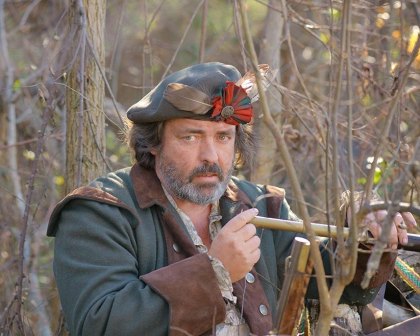
Answer: A draw. Simcoe sliced out one of Rogers’ eyes; Rogers improvised an explosive device and nearly blew Simcoe into the next life.
In the show, Rogers (portrayed with menacing perfection by Angus Macfadyen) threatens to carve up Simcoe (Samuel Roukin). “You’re old, fat and slow," Simcoe responds. "You’re the past, and I’m the future.”
Simcoe is both right and wrong. In the series, Rogers is, undeniably, old and fat. But slow? Not so much.
Even so, Simcoe has a point when he says that Rogers is the past. While much of Turn is fiction loosely based upon the lives of historical figures, it is true that Rogers’ career was steadily winding down during the American Revolution.
Our sixth post about the drama will focus on the historical Rogers, along with sources for further study:
The basics: Rogers was born in 1731 in Methuen, Massachusetts, and moved with his parents to New Hampshire. He married Elizabeth Browne, daughter of an Anglican rector, in 1761. They had one son, Arthur, but an unhappy marriage. She suspected infidelity, and in 1778, was granted a divorce. (See article on the website: Reynolda House: Museum of American Art.)
Rogers made a name for himself during the French and Indian War (1754-63): He was known for raising a tough militia force, Rogers Rangers, and adapting Indian fighting techniques. Rogers championed Indian membership in the Rangers, wrote John F. Ross in the book, War on the Run, The Epic Story of Robert Rogers and the Conquest of America’s First Frontier (Bantam Books; 2009). Famously, after a defeat in 1758, the French thought Rogers was dead. “For France, perhaps the most promising spoil of war was the discovery of Rogers’ coat on the field of battle,” Ross wrote. Much to their chagrin, Rogers later resurfaced, alive and well.
Rogers is also known for developing “Rules of Ranging” still revered by the military today. (See the rules on the U.S. Army’s website.)
Charged with treason: The ambitious Rogers wanted “to carve out for himself some sort of semi-independent fiefdom in the west,” according to a biography on the University of Canada website. In 1767 he drafted a plan in which a civil government would be formed in an area of Michigan now known as Mackinaw City. Rogers wanted to be appointed governor, but trouble arose when he was accused of threatening to go over to the French if his plan was not approved. Arrested and put in irons, he was tried by court martial in 1768 -- and acquitted. The website pointed out that he was “guilty of no crime more serious than loose talk.”
Even so, Rogers was in financial trouble. He went to England seeking reimbursement for money he claimed was owed him, but ended up in debtors’ prison for several periods, including a stint from 1772-74.
In the American Revolution: When the American Revolution began, Rogers would have been about 45 and an experienced soldier. He sought a commission in the Continental Army, but his stay in England made American rebels suspicious. George Washington didn’t trust him and said so (in so many words) in a letter to Congress. Here is a paragraph from Washington’s letter, addressed to John Hancock and found on the National Archives website:
“The Business which he [Rogers] informs me he has with Congress is a secret Offer of his Services; to the end that in case it should be rejected, he might have his way left open to an employment in the East Indies to which he is assigned, and in that case he flatters himself he will obtain leave of Congress to go to Great Britain.”
Rogers ended up working for the British and played a major role in the capture of the American spy Nathan Hale. He was appointed to raise and command the Queen’s Rangers. “Early in 1777 an inspector general appointed to report on the loyalist units found Rogers in poor condition, and he was retired on half pay,” the University of Canada website said.
But he wasn’t done yet. He was to raise another group, the King’s Rangers, in 1779. By then, Rogers was “drunken and inefficient,” the website said. His brother attempted to recruit men for the Rangers. The regiment never fought.
An unhappy ending: Rogers was captured by an American privateer in 1780. He was imprisoned and, after the war, went to England. He died in 1795.
Sources:
- Encyclopedia Britannica: Robert Rogers.
- Library of Congress: Nathan Hale.
- National Archives: From George Washington to John Hancock, 27 June 1776.
- Reynolda House, Museum of American Art: Elizabeth Browne Rogers.
- University of Canada: Robert Rogers.
- U.S. Army: Rogers’ Orders.
- War on the Run,The Epic Story of Robert Rogers and the Conquest of America’s First Frontier, by John F. Ross (Bantam Books; 2009).
Related:
Turn: John Andre, melancholy spymaster
Simcoe: Turn's British (Colonial) villain
Turn: Peggy Shippen as femme fatale
Fact, fiction and 'Turn,' the Colonial spy drama
'Turn' serves up revolutionary history
If you would like to comment, give us a shout, or like us on Facebookand tell us what you think.